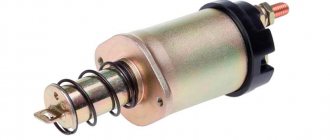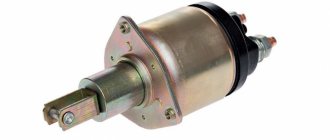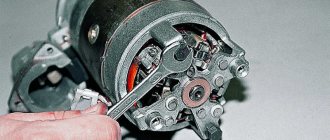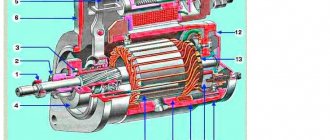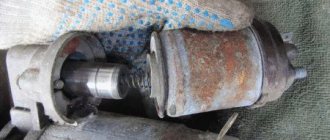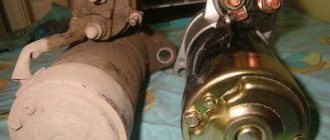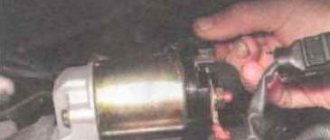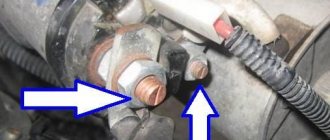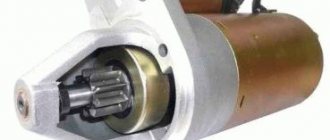A faulty starter relay is often the reason why the car refuses to start when the key is turned in the ignition. Perhaps these are not the most pleasant moments in the life of any driver. Therefore, in such cases, it is important to know how to check the starter solenoid relay, and how to start the car if it does not work.
We will tell you about the purpose of the starter solenoid relay and its structure, how you can check it and perform simple repairs yourself.
At the end of this article, watch the video that shows how to start your car if the starter solenoid relay is not working.
Also on our website you can find information about other common causes of starter malfunction with step-by-step instructions on what to do if the starter does not work.
When, when you turn the key in the ignition switch, you can clearly hear that the starter is idling, then the cause of this malfunction may be the solenoid relay. But before you start diagnosing it, you should know the purpose of this electrical unit.
Purpose of the starter retractor relay
As you know, a starter is an electric motor that is powered by a battery. When starting the engine, the starter gear must quickly engage with the flywheel ring of the engine crankshaft. At the same time, the starter electric motor is turned on, which rotates the crankshaft - this process in action is clearly visible in the animation below.
The starter solenoid relay is responsible for quickly connecting two toothed parts: the flywheel and the overrunning clutch gear (Bendix). The retractor relay is installed on the starter housing, connecting to the clutch in the front using a lever. If the relay does not push the gear forward, then the starter rotates on its own.
However, the culprit of such a malfunction may be not only the retractor relay, but also the overrunning clutch (read more about Bendix repair). If the clutch is jammed, then the force of the retractor relay is not enough to extend it.
Principle of operation
- When you turn the ignition key, voltage appears on the coil of the solenoid relay, which attracts the core.
- The core pulls the bendix out of the starter housing and engages it with the flywheel.
- As soon as the bendix engages the flywheel, a short circuit occurs, voltage is applied to the brush holder and causes the starter rotor to rotate.
- The rotor begins to rotate the bendix through the gearbox, thereby rotating the engine crankshaft and starting it.
- As soon as the engine starts, you release the ignition key, the voltage disappears on all elements of the starter and the retractor, under the influence of the return spring, disengages the bendix from the flywheel.
Checking the starter retractor relay
To determine the reason for the lack of connection between the gear elements of the starter and the engine, you should check the functionality of the solenoid relay. For ease of diagnosis, most often it is necessary to dismantle the entire starter.
However, before you begin dismantling the starter, it is advisable to carry out several simple operations that will help identify the problem:
- Check the condition of the battery, the reliability of the terminals, remove oxides from the battery terminals;
- Make sure that the electrical wiring is securely attached to the starter with nuts. If there is corrosion, clean the contacts with fine-grained sandpaper;
- Find the starter switch relay in the car and check its condition.
Starter removal procedure
To remove the starter, you need to disconnect the wires that go to it, and then unscrew the mounting bolts (usually two or three).
Often, to perform these seemingly simple operations, the motorist has to spend a lot of time and effort.
This is explained by the fact that the starter in many car models is well hidden in the engine compartment, and in order to get to it, it is necessary to remove many interfering components and mechanisms from under the hood. And in some cars, such as the Volkswagen Golf or Passat, engine support will be required to remove it.
It is best to carry out this work in a viewing hole or on an overpass.
How to check the starter solenoid relay
When the starter has been successfully removed from the engine compartment, it should be cleaned of dirt, and the oxidized contacts should be treated with sandpaper.
- Now the starter needs to be placed next to the battery and two electrical wires of sufficient length must be prepared. It is best to use wires for “lighting” that are equipped with “crocodiles”.
- The first step is to connect the positive terminal of the battery with one electrical wire to the corresponding terminal of the solenoid relay.
- After this, the other wire is connected to the negative terminal of the battery.
- All that remains is to touch the free end of the negative electrical wire to the starter housing and find out the result:
- if upon connection there is a quick and distinct click in the area of the solenoid relay, then it is working;
- if there are no signs of “life”, then the solenoid relay needs to be repaired or replaced.
If the solenoid relay is operational, the cause of the malfunction should be sought in the power circuit. Well, you can try to repair the faulty unit yourself or replace it with a new one.
Identifying signs of a problem
When the contacts burn out, the driver begins to hear clicks, indicating that the magnet is triggered. At the same time, there is an anchor in the starter, which remains motionless, and even if it moves, it moves extremely slowly. This happens when the contacts, or rather their working surface, are not completely connected, which causes:
- The copper splash is heated;
- The transient voltage begins to rise;
- An air gap immediately begins to appear.
As a result, a dielectric – oxide – appears on the surface. There is only one way you can fix everything. It is necessary to clean the deposits from the deposits that have formed. You can do this work yourself. If the damage is not large, then you can use a diamond file or use a student's eraser. When the device is severely damaged, it is better to replace it completely.
It happens that the coils short out. This happens due to moisture ingress, or if the insulating properties of the emulsion that protects the wires are lost. The latter option is definitely due to large overheating.
Among other things, you can make sure that the device we are considering is working by connecting the starter directly to the battery. For this purpose, you can use wires to start the LADA Priora engine from another car. We connect the wires to the battery and to the starter.
First the negative ones. If the relay is working as expected, then you will need to inspect the connectors, wiring and battery.
Initially, the wiring is checked for integrity. Start your inspection from the starter to the battery. Next, test the entire circuit with a multimeter; if you don’t have one at hand, a light bulb will do. The test is carried out from the battery to the starter.
Don't forget to check the starter fuse, sometimes the problem lies only there.
Repair of starter retractor relay
First, we suggest watching a video instruction on how to replace the solenoid relay yourself, and then we will tell you how to repair it.
Depending on the manufacturer, starters are equipped with a collapsible or non-demountable solenoid relay. To fix a problem with a non-separable element, you just need to buy a new part. All that remains is to unscrew the two mounting bolts, remove the faulty relay and install a new one in its place (see the video above).
In the case of a detachable solenoid relay, you can try to repair it. The repair is as follows:
- Unscrew the screws securing the housing cover.
- Sometimes it is necessary to additionally solder the ends of the winding.
- Removing the cover opens up access to find a possible problem - these are power contacts that may be worn out or burnt:
- in the first case, replacing contacts will help,
- in the second case, the problem can be solved with the help of sanding paper.
- Now all that remains is to assemble the solenoid relay and check its functionality.
- The repaired starter is installed in place, after which its operation can be tested.
And lastly, we recommend watching a video that shows how you can start a motor with a non-working starter solenoid relay.
Relay and fuse blocks on a LADA Priora car
Where is the ignition relay located in a VAZ-2114 car?
The VAZ Priora passenger car, regardless of the type of engine installed, is equipped with several junction boxes. They are located under the hood and inside the car. The use of several boxes made it possible to separate circuits with high and low currents. In addition, separate small-sized mounting blocks were installed, introduced as the configuration expanded.
Main power fuse block
The vehicle's power circuits are protected by inserts installed on the positive terminal of the battery. The block is designed to protect circuits with maximum currents. To gain access to the fuses, you need to remove the plastic cover; this can be done without the help of tools.
Block diagram and its location in the car
The removal of the most powerful circuits on the Lada Priora into a separate unit located close to the battery ensured maximum protection of the car's electrical system from overloads.
The location and designation of the inserts is indicated in the photo. Depending on the year of manufacture and installed equipment, it is possible to install fuses of different ratings.
Priora power insert block
Explanation of fuse designations
Purpose and rating of the main block inserts.
The given fuse diagram for the Lada Priora is relevant for cars without an anti-lock brake system. The introduction of a hydroelectronic unit on the Priora-2 series car led to a change in the purpose of the inserts.
Purpose of fuses on the battery for Priora cars with ABS (starting from the one closest to the terminal):
- F1 - ECM protection (30 A);
- F2 - power steering (50 A);
- F3 - generator circuits (60 A);
- F4 - similar to F3;
- F5 - power supply to the ABS unit (40 A);
- F6 - similar to F5, but rated at 30 A.
Mounting block: relays and fuses in the passenger compartment
The unit includes fuses, several relays, and tweezers designed to simplify the procedure for replacing burnt out inserts. The content of the device depends on the vehicle configuration.
Block diagram and its location in the car
The unit is located in the plastic frame of the dashboard at the bottom of the driver's side. The outside of the box is closed with a removable cover installed around the steering column and secured with three locks located along the lower edge. To remove the cover, you need to turn the latches 90 degrees and remove the element from the latches by pulling it towards you.
The oval marks the location of the block installation
On cars, fuse ratings may differ depending on the year of manufacture of the car and the configuration. To determine the value of the fuse link, you should use the operating instructions for the Lada Priora.
When repairing fuses, it is necessary to take into account that the instructions for the Lada Priora car change several times a year. It is not recommended to use a manual from another car.
The “norm” option with the additional installation of an air conditioner has differences in the Priora’s fuse circuit. Elements that protect the device are placed in a separate engine compartment, discussed below. The mounting housing itself has not undergone any changes.
Block version “norm” with air conditioning
With the start of production of the modernized Priora-2, the contents of the body changed somewhat. In the interior units of cars, only one space for a relay and two cells for fuses are empty.
Block on Priora-2
Explanation of fuses and relays
Explanation of fuses in the “norm” version.
Questions and answers How to bleed shock absorbers before installation
Read more
Questions and answers How to adjust the carburetor on a trimmer
Read more
Questions and answers How to remove the window lifter handle on a Hyundai Accent
Read more
Questions and answers How to remove a dent on a car with your own hands
Read more
Questions and answers Which shock absorbers are better to install?
Read more
Questions and answers Which carburetor is better to put on a Ural motorcycle
Read more
Questions and answers What sandpaper should I use to matt a car before painting?
Read more
Questions and answers Car stalls at idle
Read more
Questions and answers When the engine is cold, it starts and immediately stalls
Read more
Great article 0
How to start a car if the starter solenoid relay does not work
The car starter starts the engine. The Priora will not start without his participation. Without it, starting a movement is simply impossible. Sometimes the Lada Priora does not start because the fuse has blown, or the starter relay has malfunctioned; it is marked K3. Sometimes it clicks but doesn't turn. The reasons are in the details. The starter on a Priora consists of the following parts: bendex, retractor relay, armature and others - for a complete list of how many parts the starter of a Priora car contains, see the article below. It is advisable for car owners to know where this mechanism is located on a Lada Priora car - it is located immediately under the air filter. The price of the part is a starter for a Priora engine (16 valves): from 2750 to 4500 rubles. When a breakdown occurs, the device on the Priora stops turning.
There is nothing to be done - you will have to get it out and figure out the problem. Despite the rather “brute” force that the starter unit “applies” to start the engine, its structure is quite complex and consists of several fairly small parts. So, you will have to understand the relay mechanism in detail, because problems may also arise in it. Photo of the detail below.
Standard starter and analogues - article number and price
Unfortunately, if the mechanism does not work, the problem can only be solved by replacing it. Neither installing new parts under the body, nor any cleaning will save the situation. The standard starter for a Priora with 16 valves goes under catalog number 2111.3708010-01, its cost is about 4,000 rubles. As analogues we can consider:
Lada Priora starter: device and principle of operation
As mentioned earlier, this part can be installed on the Priora of two types: geared and gearless. Sometimes it may be necessary to remove the starter, note that it is located under the engine, on the right - closer to the space under the air filter.
To ensure that the starter unit does not wear out so quickly, it has a special mechanism that disengages the gear from the crankshaft flywheel - the Priora starter retractor relay. If it were not there, the service life of the unit would be greatly reduced, or repairs would be required.
Geared
This mechanism is small in size. It turns out this way because the gearbox allows you to increase or decrease the torque. The planetary gearbox itself in the car in question is located between the armature and the bendix; it serves as a “buffer” and an intermediate part between them. Thus, it does not take up so much space in the case, under which there are:
Its main difference is that the bendix is fixed on its own shaft, and it interacts with the Priora engine through a gearbox.
Gearless
A gearless starter is much larger than its counterpart, but it does the same job of receiving electrical energy from the battery and sending it to the crankshaft to start the engine. It consists of the following components:
- relay;
- an electric motor containing the traction relay cores and winding;
- brushes and holders, “brush assembly”;
- solenoid relay;
- stator;
- fork;
- contact bolts;
- anchor;
- starter mask;
- retaining ring;
- freewheel;
- front bushing and rear bushing;
- starter bendix Priora;
- gear.
The gearbox operates according to the following algorithm:
- Power is supplied from the battery through the wiring harness.
- The anchor is retracted.
- The Bendix is attached to the gear, “thrown out”, the pin contacts are closed, and voltage is applied to them.
- The armature rotates, the torque is transmitted to the bendix, through it to the gear, and it is already in contact with the engine flywheel.
- As soon as the ignition key is released, the retractor relay disconnects the bendix and the gear.
Basic faults
Externally, a breakdown of the Priora starter can be recognized by the following signs:
- “turns” and at the same time starts the engine;
- does not “twist”;
- continues to “twist” after the key is released;
- creaks, clicks are heard;
- It spins, but for too long.
The reason may lie in a faulty battery, in the starter itself and fuses. The most common are those that are most likely to disable
the car – it’s worth taking a closer look.
Doesn't turn on
If the engine does not start, the problem may be:
- discharged or broken battery;
- no closure of contacts 50 and 30;
- terminals or tips are oxidized;
- interturn closure;
- short circuit to ground;
- open circuit “starter - traction relay”;
- the ignition module is faulty;
- break in the traction relay winding;
- brush wear;
- the anchor jams;
- the additional relay or the control circuit connected to it is damaged.
Clicks won't start
If the starter clicks but does not turn, there may be several reasons:
- the gear working with the bendix does not engage with the engine flywheel;
- the bearing of the armature shaft bushings is worn out;
- the starter mount or housing is broken;
- gear or flywheel teeth are damaged.
Doesn't turn off
When the Priora starter unit does not turn on, the problem may lie in the following:
- the freewheel slips;
- the battery is discharged or broken;
- sudden and severe voltage drop in the circuit;
- oxidation of contacts.
Starter rotates slowly
Reasons for slow performance may include:
- the battery is discharged or broken;
- terminals or tips are oxidized;
- the connection of wires from the power unit to the body is very weak;
- the contact bolts on the traction relay are loose or oxidized;
- brush wear;
- a short circuit or break has occurred in the armature winding.
Why do fuses melt in a car?
Let's look at why fuses burn in a car - the most common typical reasons.
Cigarette lighter
The cigarette lighter fuse often fails. In most cases, it is not related to smoking. The cigarette lighter often contains power connectors for additional equipment (radar detectors, navigators, other auto gadgets), a compressor, chargers for mobile equipment, splitters and tees of dubious quality.
In some cases, simultaneous connection of several gadgets can lead to exceeding the maximum current in the power circuit of the cigarette lighter connector.
Such situations often arise when using an advertised additional electric interior heater powered from the cigarette lighter connector.
Washer
The failure of this fuse is associated with possible freezing of water in the tank and washer system pipes at negative and slightly positive temperatures. The mobility of the electric pump drive is impaired, as a result of which the current increases and the fuse blows. To prevent such situations, it is necessary to promptly replace the water with non-freezing liquid and clean the entire system of water.
Dvornikov
It fails if the wipers freeze to the glass or the gearbox jams. Therefore, before starting to drive in the morning in the cold season, it is necessary to check the brushes for freezing to the glass.
Heated glass and mirrors
It may burn out due to a short circuit in the electrical wiring. The weakest wiring points are in the corrugated hoses of the front doors, the trunk door, and under the driver's sill trim.
Stoves
A fuse rated at 30 Amps is usually responsible for the stove. If the heater electric motor wears out, especially the bearings and bushings, the current in the electric drive circuit increases significantly. Timely maintenance of the stove fan helps to avoid such situations.
Lighting systems
They often burn out if the power is set, non-standard lamps are installed, especially xenon lamps with an ignition unit, the current consumption of which is much higher. When increasing the rating, you should simultaneously “strengthen” the electrical wiring of the lamps by laying wires of a larger cross-section.
Engine cooling systems
They fail when the radiator fan current consumption increases for the following reasons:
- foreign objects entering the area of rotation of the fan blades;
- wear of fan motors;
- production of engine lubrication.
Engine control unit
Their burnout leads to failure to start the engine. For this reason, the driver must know where the fuses serving the engine control unit are located. Almost half of all malfunctions associated with failure to start engines are determined by their burnout.
Electric power steering
Electric power steering systems are increasingly being used in automobiles. The electric drive of the electric amplifier consumes a large current; under increased loads, the fuses often fail.
Electric parking brakes
Electric parking brakes on some car models (for example, VW PASSAT B6) are a headache for many car owners. The electric parking brakes are located in an “uncomfortable” place near the wheels.
This contributes to mechanical destruction of the housing, moisture and dirt getting inside, as a result, jamming of the engine, and blown fuses along the power circuits.
ABS systems
As a result of pump wear, the current increases and the ABS fuse blows. This leads to the inoperability of the anti-lock brake system, which is especially necessary when the road surface is in poor condition.
Central locking, power windows
The central locking drives and power windows often jam, resulting in blown fuses. Also problematic is the short circuit of the wiring in the corrugated hose of the door wiring.
Starter diagnostics to determine the cause of the malfunction
In order to determine which part of the Priora starter mechanism is failing, you need to check absolutely everything - the problem could even be with a fuse that is located far from the part. Perform diagnostics in the following order:
- Turn off the ignition and secure the car with the handbrake. Remove the negative from the battery.
- Remove the air filter and intake hose.
- Disconnect the current-carrying cable from the part that is connected to the battery positive. In order to remove it, remove the upper stud of the solenoid relay with a 13 mm wrench.
- Place neutral on the gearshift lever.
- You will need a working car battery. If you are completely sure that the battery in your Priora is fully operational, use it. Connect the cable with alligator clips to the negative terminal of the battery, the other end to the bolt on the housing of the starter unit. Before doing this, make sure that the connection area is clean. If there is dust and dirt on it, clean it with a brush.
- Connect the second cable with the crocodile to the positive of the battery, its second end to the positive on the back of the starter. When you connect everything there should be a click. It will mean that you did everything right. If there is no click, you need to check the ground just in case.
- Disconnect the negative wire from the housing and connect it to the bottom screw of the solenoid relay. Connect the positive wire to the back of the relay. If a click is heard, it means the brush assembly has failed. If it doesn't work, you'll have to buy a new starter - the relay is broken.
- The negative wire must be reconnected to the body, the positive wire to the lower screw of the relay. When connected, the starter assembly should begin to rotate and you will hear a characteristic noise. The revolutions can rise to 11 thousand per minute. If the RPM is too low and the armature turns slowly, the problem is with the brush assembly or armature.
- If the armature does not spin at all, the problem is in the winding.
- Finally, you need to connect the plus to the top stud of the pull-out relay and close the contacts. If you hear extraneous sounds, you should check the bendix and gearbox.
Relay test
First, it’s worth studying the location of the Priora starter relay, which is located in the starter unit in a small housing. Checking its serviceability is carried out in two stages.
- First, you need to ask a friend to turn the ignition key and listen to the engine compartment. If there is a click, then everything is fine with the part. If there is no click, or the armature does not spin with a click, you will have to move on to the next step.
- Connect the terminals coming from the battery with the terminal that is connected to the starter assembly with a screwdriver. If the unit works, then the relay is faulty.
Fuse
The Priora fuse box is located above the driver's left knee. Remove the plastic cover by first unscrewing the three fastening screws. The Priora starter fuse is K3, that is, third from the left in the first “line”.
You can check the additional block, which is located under the floor tunnel lining. In this case, the 15 Ampere fuse F1 is checked - the one on the far left; sometimes it is enough to change it, since repair of this mechanism is not always required.
Changing the cigarette lighter
Where is the starter relay on the VAZ-2114: photo and location + video
Most drivers do not use the cigarette lighter for its intended purpose, forgetting that many devices that use current are connected through the cigarette lighter. As a result, a common problem arises - the cigarette lighter does not work. The composition of the cigarette lighter on VAZ-2170 cars is the same as that of many other models - it is a metal spiral, which is covered with a plastic casing. A special connector is used to heat the coil. Repairing the cigarette lighter connector for minor faults is often carried out without dismantling.
The cigarette lighter fuse on a Priora can be removed quite easily. Like other Priora fuses, it simply snaps off. The usual fuse replacement scheme: identify the blown element, replace it with a new one with a specific installation location in the block. In this case, the current strength of the replacement part will depend on the location of the installation location.
It may be that replacing the fuse will not bring the expected result. Then, first of all, it is recommended to conduct a thorough check of the wire. The insulation coating on it may be damaged. You also need to check how tightly the connection terminals are inserted. It also happens that the wire that powers the device is disconnected.
Buying a cigarette lighter fuse for a Priora is not a problem today. Domestic stores offer a large selection of auto parts for various models
At the same time, it is important to take into account the advice of experts and buy factory-quality spare parts manufactured in Russia
Replacement
In order to replace the starter of a Priora car, prepare the 13th and 15th keys. Before removing the mechanism, be sure to remove the negative from the battery - this little procedure is very important this time. Next follow the instructions:
- Remove the air filter, then its housing.
- On the starter assembly, unscrew the nut that secures the terminal.
- Remove the terminal from the contact bolt.
- Disconnect the wire and terminal.
- Remove the starter assembly mounting nuts (there are 2 or 3 of them, depending on the type).
- Remove the starter assembly. Install the new one in reverse order.
Fuse power
All fuses are color coded depending on the power for which their fuse links are designed:
- The fuses for the cooling system fan (F1), heated rear window (F2), and the interior heater motor (F9) are designed for a current of 25 A;
- fusible elements of the high beam headlight fuses (F3, F4), sound signal (F5), hazard lights (F8), 15th terminal of ABS (F16), fog lights (F17, F18) protect circuits designed for a rated current of up to 10 A ;
- 7.5 A fuses protect the circuits of low beam lamps (F6, F7), instrument panel, interior lighting, brake lamps (all F10) and rear fog lamp (F21);
- side lights (F14, F15), immobilizer (F20) – 5 A fuses;
- wiper motor (F11) – 20 A fuse element;
- heated seats (F19) – protected by a 15 A fuse;
- the most powerful fuse is 30 A - protection of electrical circuits (F31 or F27).
Replacing fuses of a higher rating with a smaller one, as well as the reverse replacement, is not allowed. If a fuse protecting the light signal or active safety circuits of the vehicle blows, it is allowed to replace it with a similar one removed from the socket of the circuit responsible for comfort or others that do not affect the safety of the vehicle when it is moving. If possible, the protection of electronic circuits must be restored in accordance with the requirements of the vehicle manufacturer.
The mounting box installed in the interior of the Lada Priora contains not only fuses, but also electromagnetic relays, the switching circuit of which provides for connecting a high-power load. By using such relays, the manufacturer has achieved a reduction in the current load on the switch contacts. This prevents burning of the contact pairs installed in them. Therefore, if a certain circuit malfunctions, it is necessary to check not only the integrity of the fuse, but also the serviceability of the relay installed in the Priora fuse box and responsible for the device switching circuit.
Useful tips when using the Lada Priora starter
In order to avoid many starter malfunctions, follow a number of simple rules when operating it: – when starting the engine, turn on the starter for no more than 10–15 s and again after 20–30 s. Continuous operation of the starter for a long time can lead to overheating. If after three attempts the engine does not start, then you should check and eliminate faults in the engine power supply system or in the ignition system;
– after starting the engine, immediately turn off the starter, since prolonged rotation of the drive gear with the flywheel can damage the starter freewheel;
– it is not allowed to move the car using the starter, as this causes significant overload and damage.
Causes of starter malfunction VAZ 2170 2171 2172 Priora
Causes of starter malfunction VAZ 2170 2171 2172 Priora
Ways to eliminate the causes of starter malfunction VAZ 2170 2171 2172 Priora
External signs of a malfunction of the VAZ 2170 2171 2172 Priora starter
Battery is faulty or discharged
Replace, charge the battery
When the ignition is turned on, the starter armature does not rotate, the retractor relay does not operate
Terminals and tips are oxidized
Clean, stretch contacts, lubricate with grease containing copper dust
When the ignition is turned on, the starter armature does not rotate, the retractor relay does not operate
Interturn short circuit, short circuit to ground, break in the traction relay winding
Replace the traction relay
When the ignition is turned on, the starter armature does not rotate, the retractor relay does not operate
Open circuit starter traction relay
Check the wires, connections, check the wire from contact 50 of the starter to the ignition switch
When the ignition is turned on, the starter armature does not rotate, the retractor relay does not operate
The contact part of the ignition switch is faulty, there is no short circuit between contacts 30 and 50
Replace the contact part of the ignition switch
When the ignition is turned on, the starter armature does not rotate, the retractor relay does not operate
Traction relay armature jammed
Remove the relay, check for ease of movement of the armature, and for the absence of wear on the mating parts
When the ignition is turned on, the starter armature does not rotate, the retractor relay does not operate
Burnt commutator, stuck or worn brushes
Clean the commutator, replace the brushes
When the ignition is turned on, the starter armature does not rotate, the retractor relay does not operate
Damaged, faulty additional starter relay
Check and replace the relay (installed at the bottom right side of the passenger side in the instrument panel)
When the ignition is turned on, the starter armature does not rotate, the retractor relay does not operate
Malfunction in the control circuit of the additional starter relay
Check wires and connections (there may be problems with the controller)
When the ignition is turned on, the starter armature does not rotate, the retractor relay does not operate
Battery is faulty or discharged
Replace, charge the battery
When the starter rotates, the armature does not rotate or rotates too slowly, the traction relay is activated
Terminals and tips are oxidized
Clean, stretch contacts, lubricate with grease containing copper dust
When the starter rotates, the armature does not rotate or rotates too slowly, the traction relay is activated
Loose wire connections from the power unit to the body
When the starter rotates, the armature does not rotate or rotates too slowly, the traction relay is activated
Contact bolts on the traction relay are oxidized or loose
Clean the bolts, tighten the nuts of the bolts
When the starter rotates, the armature does not rotate or rotates too slowly, the traction relay is activated
Burnt commutator, stuck or worn brushes
Clean the commutator, replace the brushes
When the starter rotates, the armature does not rotate or rotates too slowly, the traction relay is activated
Open or short circuit in the armature winding
When the starter rotates, the armature does not rotate or rotates too slowly, the traction relay is activated
Battery is faulty or discharged
Replace, charge the battery
When the ignition is turned on, the traction relay is activated and switched off repeatedly
Interturn short circuit, short circuit to ground, break in the traction relay winding
Replace the traction relay
When the ignition is turned on, the traction relay is activated and switched off repeatedly
Large voltage drop in the traction relay circuit due to oxidized contacts
Clean and stretch contacts
When the ignition is turned on, the traction relay is activated and switched off repeatedly
Freewheel slipping
When the starter is turned on, the armature rotates, the flywheel does not rotate
The drive gear does not engage with the ring gear, noise is heard (wear of the engagement part)
Replace gear drive or flywheel
When the starter is turned on, the armature rotates, the flywheel does not rotate
Wear of bearings (armature shaft bushings)
Replace bearings or starter caps
Starter noise when rotating the armature
The starter is loose or the cover on the starter side is broken.
Tighten the nuts, replace the cover
Starter noise when rotating the armature
Damage to individual teeth of the drive gear or flywheel ring
Replace gear or flywheel
Starter noise when rotating the armature
Jamming of the coupling along the splines of the shaft or armature in the traction relay
Clean the splines, lubricate or replace the traction relay
Starter gear does not disengage from flywheel
3. Removing and installing the VAZ 2170 2171 2172 Priora starter.
You will need: ring wrenches “13”, “15”.
1. Disconnect the wire from the negative terminal of the battery.
2. Remove the air filter (see “Removing and installing the air filter”).
3. Unscrew the terminal securing nut. 4. Disconnect the wire with the terminal from the contact bolt of the traction relay.
5. Disconnect the wire from the traction relay terminal.
6. Unscrew the nut of the upper mounting stud.
7. Then the stud nut for the lower starter mounting.
8. Remove the starter from the vehicle.
9. At the start of the Lada Priora car, install it in the reverse order.
